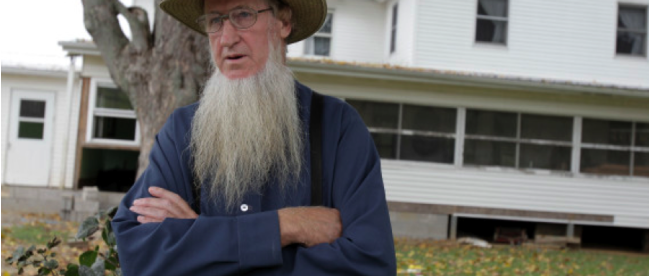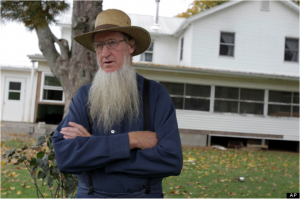Is Shaving Someone’s Beard Really a Hate Crime?

Let’s face it: the world in which we live has been scarred time and time again by religious intolerance, racial inequality, and a host of other discriminatory activities. So, what is the latest discriminatory fad to furrow the brows of Constitutional law scholars? Beard trimming.
That’s right. In a recent verdict, an Ohio jury convicted 16 members of an Amish sect who were involved in a string of attacks against other Amish individuals. The attackers’ M.O.? Forcibly pinning down their victims and using shears to cut the victims’ beards and hair. The aptly-named Samuel Mullet, Sr. orchestrated the attacks on individuals who questioned the harsh methods he employed as leader of the sect.
The case first drew attention largely because of the bizarre nature of the attacks. But the verdict is also particularly relevant as it pertains to the reach of federal hate-crime laws in the United States. First, some background: In 1969, the U.S. Congress took a major step by recognizing the need to impose harsher sentences on criminals who are motivated by the victim’s race, color, religion, or national origin. Proponents of hate-crime laws reason that hate-crimes may effectively intimidate other members of the victim’s community, leaving them feeling isolated, vulnerable, and unprotected by the law. Proponents see a need for enhanced punishment to deter the behavior.
Over the past several decades, numerous high-profile incidents—such as the brutal murders of James Byrd, Jr. and Matthew Shepard—have led to increased public awareness of hate-crimes. Consequently, lawmakers have continued to push for more expansive hate-crime laws in an effort to combat the attacks. The latest major expansion came in 2009, when Congress passed the Matthew Shepard and James Byrd, Jr. Hate Crimes Prevention Act. The Act expands the 1969 federal hate-crime law to cover crimes motivated by the victim’s gender, sexual orientation, gender identity, or disability. As a result, hate-crime laws have continued to become applicable in an increasing number of circumstances.
Fast-forward to the beard shearing fiasco. According to a Department of Justice report, “[t]he manner in which Amish men wear their beards and Amish women wear their hair are symbols of their faith, according to trial testimony.” The cutting of the beards and hair, therefore, has obvious religious connotations. But the defense did not take the “hate-crime status” of the acts lying down. The defense claimed these acts were merely the result of personal vengeance within the Amish community, and should not be viewed as hate-crimes motivated by the victims’ religion. The jury ultimately disagreed, viewing the attacks as efforts to suppress the victims’ free practice of religion.
The jury was right, but beard shearing itself should have little to do with the jury’s decision. The federal hate-crime laws allow for enhanced punishment of crimes motivated by the victims’ religion. The victims in this case merely wanted to practice their religion in the way they chose, rather than succumbing to Mullet’s extreme practices. Suppose that instead of shearing off the victims’ beards, Mullet and his cohorts punched them in the face. The hate-crime laws would still be in play, as Mullet’s motivation for attacking the victims is still based on the victims’ religious views. The fact that the beard shearing has additional religious significance is irrelevant when deciding whether or not the hate-crime laws apply.
To further the point, suppose a non-religious factor motivated Mullet. Suppose Mullet orchestrated the attacks on the individuals because they, let’s say, made an offensive remark about his mother. The attackers show up, the beards are sheared, and the attackers are arrested. Would the hate-crime laws be in play? Probably not. Even though the beard shearing has religious connotations, the fact remains that Mullet was motivated by the remarks that were made, not by the victims’ religious ideals.
The jury was correct in this case—these attacks were motivated by the victims’ religion and were hate-crimes. Despite all of the media attention on beard shearing, the religious connotations related to the shearing are actually irrelevant to the hate-crime status. Both the increased public awareness of hate-crimes in recent decades and lawmakers’ continued efforts to expand the applicability of hate-crime law lead to the following question: how much of a religious connection suffices to label an attack as a hate-crime? Would the mere cutting of a beard, uncoupled with religious motivations, have enough religious significance to invoke hate-crime laws? For now, the law requires that the focus remain on motivations for an attack rather than religious connotations associated with the attacker’s M.O.
The Amish beard should be revered
But Mullet came; the beards were sheared
The 16 suspects were commandeered
The Amish fear has disappeared.


Really interesting story and discussion of hate crime law! The law is obviously very important to protect certain groups of people, but I would have never imagined it being applied in this context.
Breaking news:
http://www.nytimes.com/2013/02/09/us/amish-sect-leader-gets-15-years-in-beard-cutting-attacks.html?hp&_r=0
he is going to jail for 15 years!